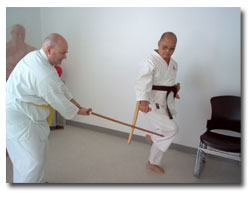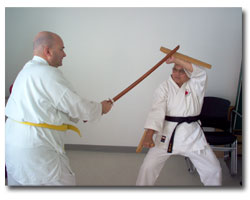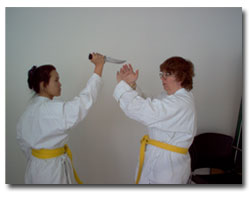written by Ken Chun
For the past twenty-three years that I’ve been practicing martial arts, I’ve gotten the same question time and again: “How do you do martial arts from a wheelchair?” I have a simple answer: “observation and adaptation”. Using what I have observed from the martial arts of Filipino Kali and Jun Fan Gung Fu in the last seven years, and taking my inspiration from Mr. Ron Scanlon, himself a martial artist who uses a wheelchair as well as an instructor in a form of Kung Fu called San Soo, I have come up with several adaptations using my wheelchair as a weapon. Please note that these are my observations and they work for me. If you ever attempt to use any of these you do so at your own risk. I am merely sharing these for your information, not instruction.
Removable arms – using FMA angles one and two you can disable an attacker by striking the collar bones or the knees, or by using angle five and thrusting the tip (or tips) of your wheelchair arm into an attacker’s solar plexus or abdomen. You could also use angles nine and ten to the knees, but I wouldn’t advise using more than four angles because then you risk having your weapon taken from you and used against you.
Quick-release legs – Using FMA angles eleven and twelve you can disable an attacker by striking his knees as hard as possible, but be prepared to drop the legs and use a follow up with your hands such as the plum from Muay Thai where you can then elbow or punch.
Using the footrests on the wheelchair while moving toward an attacker and ramming into the ankle or shin you can stop the attacker’s leg in the same way that a pendulum (or shuffle) kick from Jun Fan Gung Fu or a foot sweep from any number of other martial arts would do. The attacker may fall forward from this, so be ready to move quickly and use a follow-up from Muay Thai such as “jab – cross – plum – elbows or punches to the head” (can you tell I like this follow up?) or, simply move out of the way if you’re quick enough and let him fall to the ground. Then you can use your footrests again against the attacker’s head. Your wheels are also a weapon. Rolling over an attacker’s hands while he’s down on the ground has a wonderfully demoralizing effect, especially if you do it slowly.
To use the wheelchair to do a sweep like in Muay Thai (or other martial arts), swing the legs of the chair as fast as you can and as hard as you can to catch an attacker’s heel, ankle, or calf. This will either trip him or put him off balance and most likely cause him to fall into you as in the above situation. From that position you can do either a choke or execute an arm lock by hooking the arm closest to you as he falls and introducing his hand to his shoulder blades.
As with any technique, they do not always work as they should so be prepared to improvise and adapt to whatever happens. Remember, the main goal is to protect yourself from harm and get away as quickly as possible. When the odds are against you, do what you have to in order to get away and stay safe.
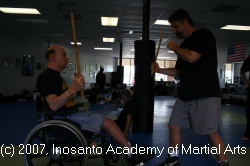
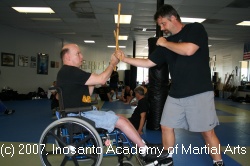
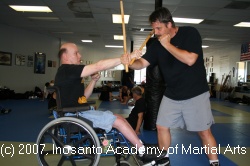
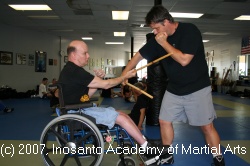
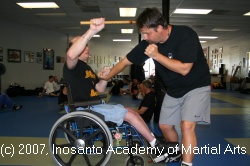
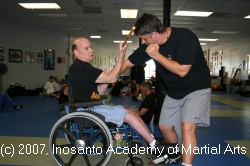
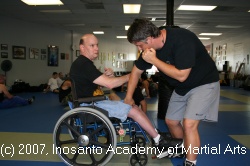
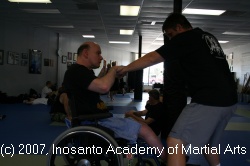
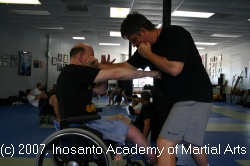
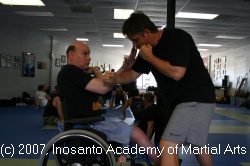
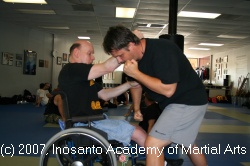




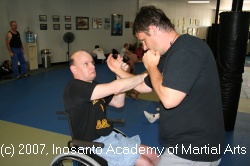
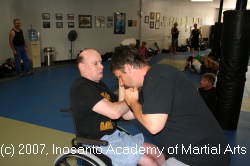

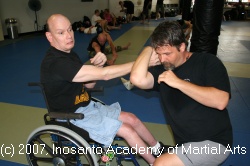

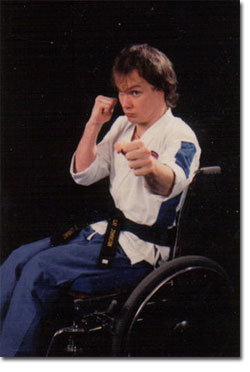 This article is about being a disabled martial arts instructor. As of March 1, 2007, I’ve been teaching the martial arts for 20 years. I would like to tell you the story of how it all started.
This article is about being a disabled martial arts instructor. As of March 1, 2007, I’ve been teaching the martial arts for 20 years. I would like to tell you the story of how it all started.